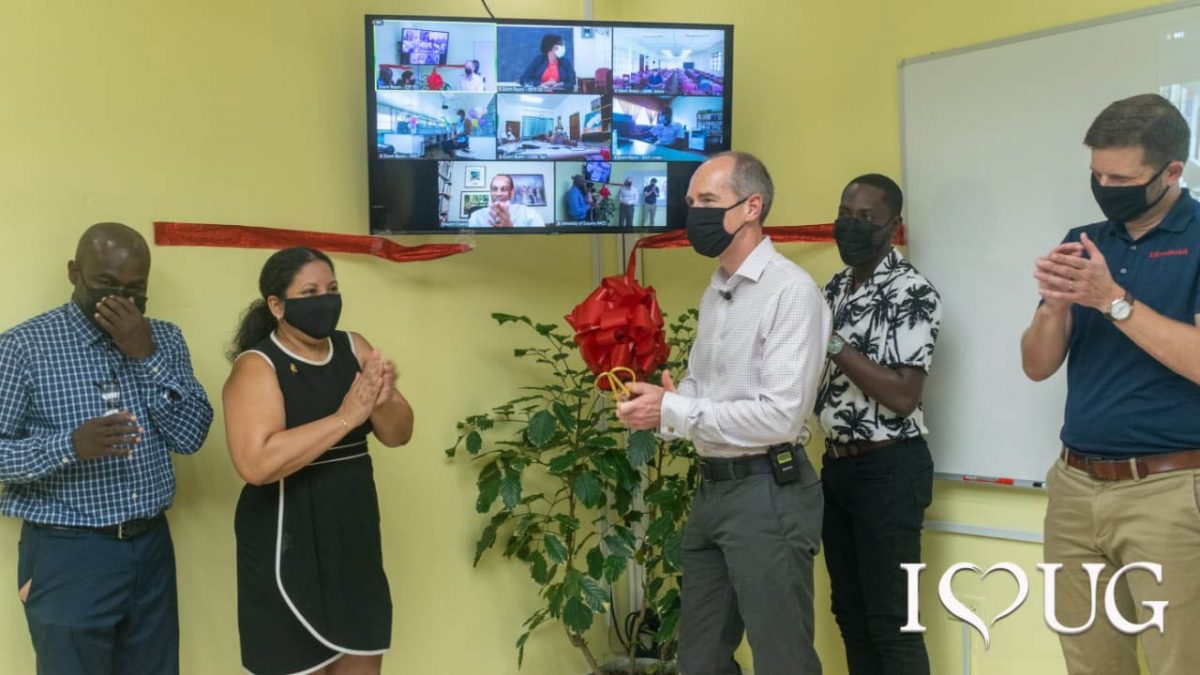The University of Guyana (UG) has launched 18 Zoom Rooms to enhance virtual classroom experiences for its students and staff.
A brief ribbon cutting ceremony was held at the UG Centre for Information Technology (CIT) building, at the Turkeyen Campus, for the Zoom Rooms or technology rooms, which were developed as part of the Greater Guyana Initiative of the Stabroek Block co-venturers, ExxonMobil, Hess and CNOOC Limited.
The 18 Zoom Rooms, which cost approximately US$85,000, is anchored at the CIT and linked to the Tain Campus and will connect persons attached to the university with access to lectures and laboratories whether they are on the campuses or elsewhere.
UG Vice-Chancellor Dr. Paloma Mohamed-Martin told Sunday Stabroek that US$70,000 was given by the co-venturers and the university added about US$15,000, which collectively covered the infrastructure costs.
According to the Vice-Chancellor, talks about making the rooms a reality started in August 2019 but the plans were interrupted when the pandemic hit. However, she said that the pandemic boosted the idea to have added rooms rather than just one, which was being considered in the beginning. “It was initially meant for one information room to facilitate the higher education for our staff who are doing high degrees and working with lecturers at universities across the world and when COVID hit and we encountered these problems, we passed the project and decided instead of one information room, we did 18,” she explained.
She said immediately 750 students would benefit from the initiative. “In the past we couldn’t get to all of those because we didn’t have space but now we could be at this campus and reach students in Anna Regina and Mabaruma and other parts that have access to internet. It makes a difference.”
A demonstration of how the rooms operate was conducted by Director of the university’s Tactical Online Services Unit Malcolm Williams. He briefly explained that with this technology, lecturers can be in their labs or lecture room and easily connect to their learners who may be at home but still get to see exhibits in real time as would happen during face-to-face lectures. During his demonstration he also noted that work which would be written onto the whiteboards will be completely visible to the classroom through the camera. Zoom-ins will also allow for learners to get a better view of the environment around the lecturer.
Mohamed-Martin further noted that the project has prompted discussions about how flexible virtual classes are especially for when the University re-opens for face-to-face teaching. “Whenever we come back, because we still can’t be this close and packed up in a classroom, we envision students can stay in their homes or where ever they are, or even on campus in some of the gardens; if they are working they can even be in a space in their office. It gives a huge amount of flexibility once everything works,” the Vice-Chancellor posited. She added that this opportunity was probably considered in the past but added that it takes a team to plan and efficiently carry such a project that works. She added that seeing this project in action changes the delivery of education and the way the university works.
Having such technological options, Mohamed said, has broadened the spectrum for student applications. She stated that the university is now considering ways to carry out virtual classrooms which can be accessible to students who want to study at the university but are living in other countries. “We are looking at students out of Guyana because it gives an opportunity for us to teach people from the Caribbean region and from other parts of the world,” She suggested that with the competitive fee structure offered at UG, persons would be delighted to join. “We are really rejigging our entire offerings right now. It should be very exciting when you see us emerge in the next couple months.”
The GGI is a 10-year commitment implemented by the co-venturers in offshore oil development in the Stabroek Block of more than G$20 billion (US$100 million) which is to be used to significantly expand capacity building efforts and promote sustainable economic development in Guyana.
Allistair Routledge, President of ExxonMobil Guyana, shared that the company is excited to continue with venturing into projects which will benefit the country. He explained that ExxonMobil has committed to the Greater Guyana Initiative and the oil company is very happy to be a part of the project. “We are very happy to help the resource in the country. We also believe that with this comes an obligation to not only help through revenue but through energies and bring other benefits to the country and to the world.”






